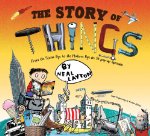Through the Looking Glass Children's Book Reviews
The Story of Things: From the Stone Age to the Modern Age in 10 Pop-Up Spreads
For ages 7 to 9
Hodder & Stoughton, 2012 ISBN: 978-0340945322
In our world, we are surrounded by things; by furniture and gadgets, books and toys, and who knows how many other objects that we consider essential. There was a time though, when humans did not have things. They gathered their food and lived very simple lives. Then one day something special happened; humans learned how to make tools out of stone. They made stone weapons so that they could kill animals, and they used stone knives to cut up the animal skins to make clothes. They have possessions.
Over time, humans started moving away from being hunter gatherers. Instead, they learned how to domesticate animals and farm the land. They started “living together in bigger groups.” They built homes out of clay bricks, and made useful containers out of wood, clay, and reeds.
Groups of people moved to new lands, and civilizations “came and went.” In each civilization, new innovations meant that people began to make new things. The invention of the wheel gave rise to carts in Sumeria, and when the Romans came onto the scene, they developed showers, soap, books with pages, and all kinds of things.
The Middle, or Dark Ages, is often considered a time of stagnation, but valuable new things did come on the scene at this time. Many handwritten books were made, people put buttons on their clothes for the first time, and the Chinese invented gunpowder.
When the Renaissance came around, inventors, artists, and other people went a little crazy, and an incredible array of inventions and artistic creations were developed. Many of the inventions would change the history of humankind forever.
In this remarkable book, the author combines humorous illustrations and sections of text with Corina Fletcher’s clever novelty features to give readers a history of “things” that they will thoroughly enjoy exploring. There are tabs to pull, pop-ups, mini books and other paper engineered creations on every spread, and readers will learn a great deal about man’s passion for making “things.”




